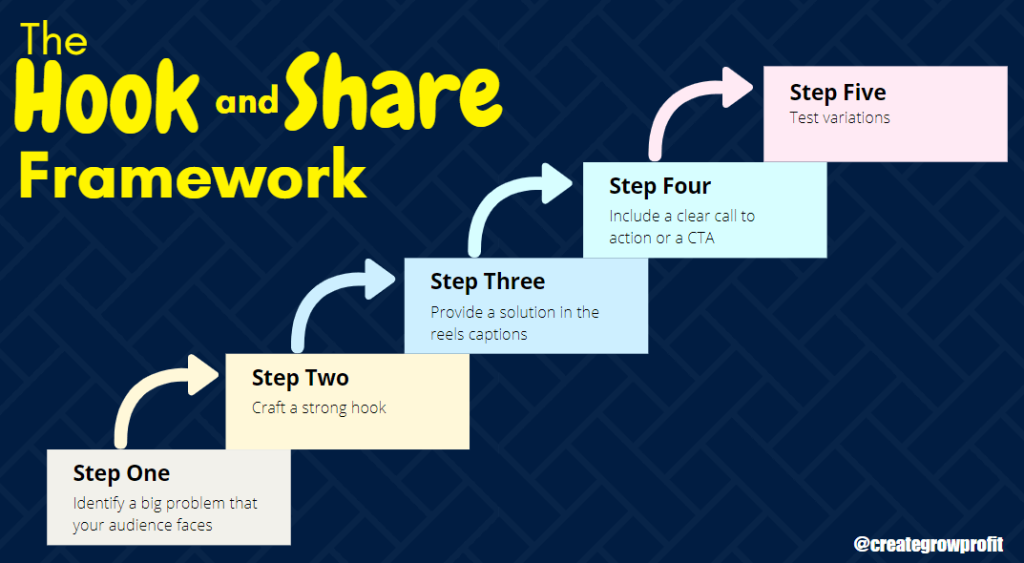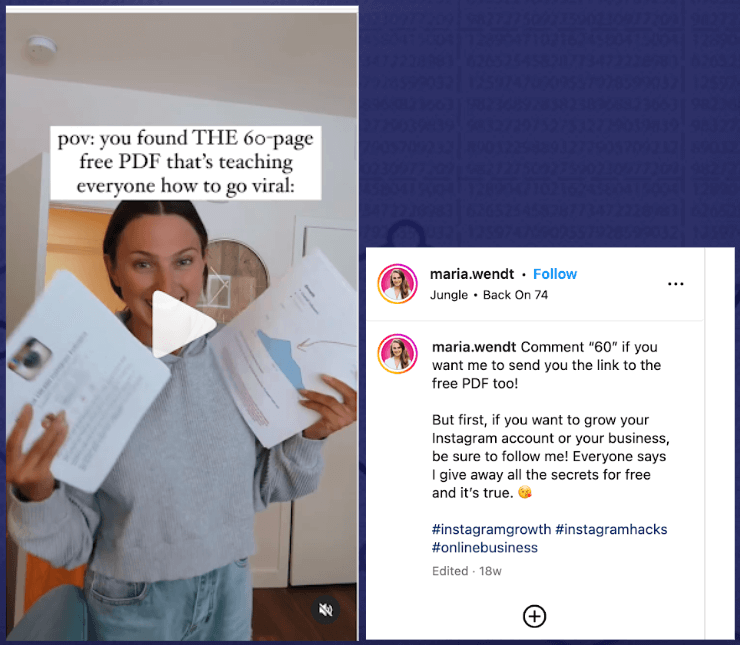
I studied successful creators and found out how to create a viral reel on Instagram.
For about 2 years, my entire business model has revolved around create, grow, and profit.
Creating a viral reel on Instagram helps with two of these steps:
- It’s creating content
- Growing an audience
The problem with Instagram reels is that if you don’t figure out how to get more views, you could waste months and months of your time without growing your business at all.
So I studied successful and unsuccessful reels from different Instagram accounts to create a framework that you can copy. I’m going to give you a couple of examples and then at the end of this article, I’m going to reveal this framework.
As a first step, I needed to set the benchmark for what going viral even means.
How do we objectively measure this? Is it 10,000 views, 100,000 views, or a million views? So I did what any expert would do, I Googled it but in all seriousness, I believe that going viral means that you get more views on one of your reels than you usually get on Instagram.

That also means that different creators have different benchmarks for going viral.
As an example, let’s say you typically get 2,000 to 3,000 views on your reels then if you have a real that gets 10,000 views, I would consider that as going viral.
What’s your benchmark for going viral? Please let me know in the comments below.
Viral Reel Examples
Example #1
Alright, let’s start analyzing some of these reels and build the framework that you can copy.
Here is Maria went. As I’m recording this, she is a business coach with 190,000 followers on her Instagram account. That’s a huge number, right? But if you look at her reels, not all of them have millions of views or not even 10,000 views.
Actually her followers increased after she had one of her reels go really viral. This is the reel that I’m talking about.
Let’s try to understand two things:
- Why this particular reel went viral?
- Why her old version didn’t get as many views?
Her successful reel got over 2 million views. Why is that?
- First: She Had A Great Hook. She had a great hook saying, “This is the 60-page free PDF that teaches everyone to go viral”
- Second: The sheets in her hand created excitement. She’s not just talking about the PDF. She’s holding it in her hands and showing it to us. Making it tangible and real. Also, very important, there’s movement in the first few seconds of the reel as some of her pages fall down.
- Third: She added a strong Call to Action. She told her viewers clearly how they can get their hands on the PDF. That’s exactly the type of content the Instagram algorithm loves because it gets views, likes, comments and shares which means all the engagement metrics go up.
But now comes the really interesting part, I think, if you scroll down her reel library, you can see that she has already posted a reel sharing the exact same 60-page free PDF.
It’s the same content but it got only 36,400 views. Here’s why I think her older reel didn’t perform as well: it’s called pacing.
Pacing is something that I find very difficult to quantify but it is crucial to the success of all your Reels.
Pacing is basically how fast the Reel moves along. Faster pacing doesn’t always mean it’s better, good pacing simply means that the speed is perfect for the viewer experience.
I think comparing these two variants by Maria is a fantastic example to see the effects of different pacing. You can see that her viral real with over 2 million views has more movement from the very beginning.
Her Viral Reel has the following elements:
- Her Pages fall down but then, also, she swipes through the pages ultra-fast
- Not only that, it also transitions from one sequence to the next at a higher pace
While her Older Reel has:
- Less movement in the video
- It also feels a bit like it’s dragging on
Pacing is extremely difficult to nail down but the key is that you start practicing it and if you can work with a friend or a coach and together you review the pacing in your videos, that’s even better.
Clearly, Maria was testing different variations of this reel. These are just the two that we find on her profile. There could be other variations that she tested and may be deleted.
And I think that’s why she’s successful. She didn’t just create one real and accepted whichever result she got. She really did the extra effort to test different variations
Example #2
Let’s analyze another real.
This is Christina, an Instagram growth and sales coach. At the point of recording this, she has about 3,800 followers while she usually gets a few thousand views on her reels. This one reel has over 1 million views. Why did this one go viral?
Let’s have a look.
- She has movement at the very beginning of the video and she has a strong hook. The hook is strong because she’s addressing a big problem that all aspiring Instagram creators have. It’s reaching non-followers.
- While her hook addresses the big problem, the solution to that problem is actually in the captions of that reel. So what happens is that people start reading the captions while the reel keeps playing over and over in the background. That’s another thing the Instagram algorithm loves. It loves reels that are being rewatched.
- See how her caption is not just a solution but it also is a Call to Action. It asks people to comment on the real which boosts engagement.
- This is probably the most overlooked metric and that is sharability. 9.2 thousand people shared this reel with others which is another reason why it got more views and went viral.
Instagram CEO Adam Mosseri recently said in an interview that the Instagram Reels’ algorithm favors reels that people share.
So after studying reels from accounts like Maria and Christina, here’s the framework that I’ve put together and I hope that you really give this a try, step by step to hopefully make one of your reels go viral.
Also if you find this helpful, please don’t forget to share this article. I also have a video of this. Please like and subscribe to my channel.
So I call this framework The Hook and Share Framework.
The Hook and Share Framework

Step One: Identify a big problem that your audience faces. If there are many problems, then make a list and organize it.
For example, if you’re targeting coaches, one of their big problems could be that they struggle to attract high-paying clients.
Step Two: Craft a strong hook. The problem that you picked, you want to address that in the hook. The key is to make your hook:
- Clear
- Engaging
- Address the problem directly
- Avoid making it complex
- Make it visually appealing by adding movement to the very beginning of the video and showing some kind of proof if possible
Whether that’s you holding something in your hand or sharing a screenshot or something else
As we just saw for example, Maria held the printed-out PDF in her hands and Christina shared a screenshot from her Instagram metrics.
And as we saw in both of their examples, they both had movement from the very beginning of the reel whether that’s Maria dropping some of her sheets or Christina walking across the screen.
Step Three: Provide a solution in the reels captions. So while the video reel addresses the problem, the caption provides the solution to that problem.
This encourages your viewers to read the captions while the video keeps playing over and over. Just consider the following when making your video:
- Be sure to provide a detailed solution but use clear and simple language
- Avoid long and complicated sentences
- Also, think about which keywords you can include that are relevant to your content
Step Four: Include a clear call to action or a CTA. So your audiences read the hook, the video is engaging and they’re reading the captions, what’s next? You want to encourage your audience to interact with the reel.
You can ask them to comment, share, or perform another action that boosts engagement with your reel. If you can give away a free resource that solves their problem, then tell them to leave a comment and you will send it over to them.
This way you’ll get even more comments and even more engagement on the reel. And whatever you’ve promised, you can send it to the people who commented through a DM.
If you’re struggling with the idea of call to action, here are a few examples :
- Comment “COACH” if you need this strategy guide
- Share this with a friend who needs more followers
- Tag a creator who needs fresh ideas
- Save this for your next workout plan
Step Five: Test variations (in my opinion, this is the very important step)
Just because you’re using a framework like this or somebody else’s framework, you’re not guaranteed to go viral just because you do it one time.
For every single one of your reels, think about variations and create as many of them as you can by repeating this framework. With each variation, you get better at this process until hopefully, one of your reels goes viral.
I’m starting to use the exact same framework in my Instagram reels and in my YouTube shorts. So if you want to see my failures and some of my successes, then be sure to follow me on Instagram @creatrgrowprofit and subscribe to my YouTube channel.
I’m currently studying viral posts on all of the major social media platforms and I’m creating more frameworks like this.
My Three Takeaways
- Your hook is crucial. Both Maria and Christina had strong hooks that grabbed attention in the first few seconds. If you don’t catch viewers’ interest immediately, they’ll scroll past.
- Pacing sets the tone. The speed and flow of your reel can make or break its performance. Too slow, and viewers lose interest; too fast, and they might feel overwhelmed.
- Viral success takes time. Don’t expect instant results—viral reels often come after a lot of testing and learning. Stick to the framework, keep experimenting, and you’ll improve over time.
And don’t forget to subscribe on my YouTube channel, @creategrowprofit
If you are a coach or consultant, and your goal is to get your very first client online, then I have a simple strategy for you that’s very beginner friendly, you can download this strategy for FREE from my website at CreateGrowProfit.
Thank you and see you on my next blog!


